Handbook
posted 12-10-'02 / 8-06-'22


If you find this manual useful,
how about a donation of $3 to:
M. Butkus, 29 Lake Ave.,
High Bridge, NJ 08829-1701
and send your e-mail address
so I can thank you.
Most other places would charge
you $7.50 for a electronic copy
or $18.00 for a hard to read Xerox copy.
This will help me to continue to host this site,
buy new manuals, and pay their shipping costs.
It'll make you feel better, won't it ?
If you use Pay Pal, use the link below.
Use the above address for a check, M.O. or cash.

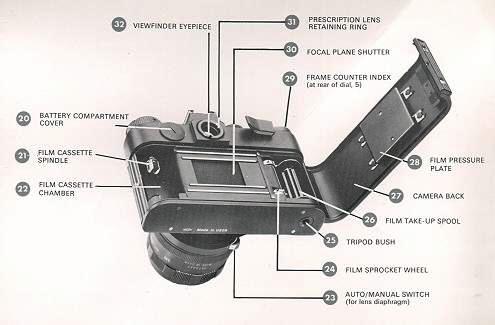
Introduction
You can be justly proud that
you have chosen the Zenith TTL*_ the latest and most advanced 35mm reflex
camera from the U.S.S.R. * Through-the-lens metering offers many advantages
over other metering systems. Close range pictures with the aid of bellows or
extension tubes; using filters or teleconverters; taking pictures with the aid
of a microscope (photomicrography) -- all become easy and straightforward,
since the meter cell determines the amount of exposure required (and thus
automatically compensates for same) by reading through the accessory in use.
This handbook has been systematically written and designed to take you through
all the operational and handling features of your new camera in easy stages.
Though many hints and tips
towards better photography have been included, this handbook should in no way
be thought of as a comprehensive guide to general photographic techniques.
There are numerous useful books of this type available and if you are just
taking your first shaky steps in photography it would certainly benefit you to
consult your local library or bookshop.
Your Zenith camera is sturdily built and will work happily under widely varying conditions. Do remember, though, that it is a precision-built optical instrument and should therefore be handled carefully and protected from violent shocks, damp, dust and sand and sudden changes of temperature. Take care of your camera and it will give you years of reliable service and brilliant pictures. The wide range of accessories available, particularly those from the U.S.S.R. which offer outstanding value-for-money, enable you to cope with almost any photographic situation. You can build up as complete a system as you need at your own pace.
To get the best possible results from your Zenith, study this book thoroughly to make sure that you are familiar with the essential features of the camera before you start taking pictures. Refer back to the book any time there is something you are not sure of. Many operational features of this camera are unique and probably somewhat different from other cameras you may have owned. It is therefore strongly recommended that after carefully reading the instructions you shoot a 'test roll of film, have this film processed, and examine the pictures before exposing additional rolls. This test roll will verify that you are using your new camera correctly and allow you to make any necessary changes in camera operation. Additionally, it will confirm that all the camera controls are functioning perfectly.
N. B. A policy of continual product development means that there may be minor differences in design or specification between your camera and these instructions.
The illustration/description of equipment and accessories throughout this book is for information only and should by no means be considered an offer of sale.
Contents
| Specification p.2 Loading your camera p.3 Picture-taking technique p.7 Your TTL Meter and how to use it p.8 Exposure hints p.10 Setting camera and lens controls p.1 2 Choosing shutter speeds and apertures p.14 Viewing and focusing p.16 Depth of field p.18 |
Taking the picture p.21 Removing exposed film p.22 Taking flash pictures p.24 Using the self-timer p.26 Changing lenses p.28 Care of camera and accessories P.30 Trouble-shooting p.32 Taking better pictures p.34 Choosing lenses and accessories p.37 |
Specification
Format - 24 x36mm; using standard 35mm cassettes of 12,20, 24 or 36 exposure color or black and white film.
Shutter Horizontal traveling Focal Plane type, speeded 1/30, 1/60, 1/125, 1/250 and 1/500th second plus B (brief time). Linked to self-timer giving approximately 7 seconds delay.
Flash Synchronization Electronic flash only at 1/30th sec. through a standard 3mm co-axial -- socket.
Viewing/Focusing system Eye-level pentaprism/instant return mirror shows upright laterally correct image. Bright Fresnel focusing screen with central ground glass/microprism spot.
Exposure meter Built- in CdS cell with needle coincidence through viewfinder, calibrated for 6-500 ASA /l 3--28 DIN. Power source Mallory or Ever Ready PX625 Battery. (Should be replaced once a year.)
See this link on a Wein Air replacement battery.
Frame counter Additive 0--36 manual resetting type.
Standard Lens-Helios 44M 58mm focal
length
Construction- 6 elements in 4 groups
Diaphragm type-Fully automatic instant re-open Optional manual
over-ride
Aperture Range- f/2-f/16 with click stops at full and half apertures
(except between f/11 and f/16)
Distance Scale-0.55-Infinity
Angle of View - 40degrees
Filter Size - 52mm screw 54mm push-on
Lens mount -'Universal' (42mm) thread accepts standard single pin
automatic lenses and accessories
Loading your camera
Precautions:
(a) Your Zenith camera accepts any standard 35mm cassette, of color or black and white film.
| 1. Raise
the Back Lock-catch (16) and swing the Camera Back
(27) open. 2. Before loading ensure rewind release mechanism has been cleared. The Rewind Release Ring (4) must be turned clockwise so that the three dots are fully lined up. Turn Film Transport Lever (2) through a couple of short strokes till no further movement is possible while applying light finger pressure to the back Sprocket wheel (24). The Sprocket should rotate in time with the lever action and not 'free-wheel. 3. Push up the Cassette Retaining Spindle (21) from inside the camera. Place the cassette into its chamber (22) ensuring that the cassettes projecting end faces down. Push Rewind Knob (18) back to its original position to hold the cassette in place -- you may need to turn it clockwise a little until it seats properly in the cassette spool. 4. Draw out from the cassette enough film (about 3m) to insert the leader into the Take-up Spool (26). The leader can be inserted into any one of the spools slots. Ensure that one perforation hole is caught by the Take-up Spool tooth, also see that the Sprocket wheel (24) engages in a perforation. |
|
|
|
5. Make sure film cassette lies flat,
then alternately depress Shutter Release Button (3) and turn
film Transport Lever (2) until perforations on both sides of
film are engaged by the Sprocket Wheel (24). The film should
also be taut around the Take-up Spool-- turn bottom spool-flange with finger
towards cassette position to take up any slackness.
Note -- Film is advanced by sprocket drive, so it is most
important for sprockets to engage film perforations properly.
6. Complete film wind, if necessary,
to its limit. Press Shutter Release Button (3) then close the
Camera Back (27). Firm pressure only is required as the back
has a self-locking catch.
7. Take up any slackness of film within the cassette
(especially important with shorter than 36 exposure lengths) by slowly turning
Rewind Knob (18) clockwise till slight resistance is felt.
|
9. Now turn Frame Counter Dial (5) until the number '0' shows against the Frame Counter Index (29) and press the Shutter Release (3) once more.
10. If you are ready to take photographs, wind Film Transport Lever (2) fully. .. and your first film frame is in position, as shown by the Frame Counter Index (29). |
|
Notes
|
(b) To maintain accuracy in use, the Frame Counter Dial (5) must be zeroed only after winding the film/shutter. After this, every time you wind on, the dial will come to rest with the next division opposite the Counter Index (29). The counter tells you how many frames (pictures) you have taken and when it reaches 12, 20, 24 or 36 (depending on film in use), you will need to rewind the film into its cassette and put in a new film. Color film especially should not be left in the camera for long periods and for the best results should be processed as soon as possible after exposure. Incidentally, do carry a spare film -- nothing is more annoying than to run out of film just before the best shot turn up! |
Rewind knob should rotate anti-clockwise when film
is wound. |
Picture Taking Technique:
Once the camera is loaded you have to consider three aspects of taking a picture -- exposure, focus and composition. The first two of these are purely technical; the following sections, together with a little experience, will soon enable you to handle your Zenith with sufficient enough ease to leave you free to concentrate on the third aspect, composition, which is the artistic one.
Exposure:
| The camera is supplied
complete with a battery (PX 625). To check that the battery is fitted, use
a small coin (half penny) to turn the battery compartment cover
anti-clockwise for removal. |
|
|
Ensure that the battery is fitted with the + sign facing you, then re-fit the battery cover as follows. Holding the cover at an angle to the camera (see illustration), insert the lug under the rim at the top of the compartment and press the cover into position so that the two spring clips engage in the cut-outs on either side. The coin can then be used to turn the cover clockwise until it locks. |
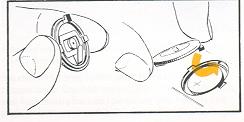 |
Meter Check
The meter needle normally zeros (comes to rest) over
the circle seen on the right-hand side of the viewfinder. Before using the
camera ensure the meter is working by setting the Film Speed Selector
(17) at 500 ASA, the Shutter Speed Dial (1)at 1/30th sec and the
Aperture Ring (14) at f/2. Point the camera at any bright
light source and, while looking through the viewfinder, depress the Shutter
Release Button (3). Continue depressing the Release Button
until it activates the meter switch which should deflect the meter needle
upwards past the + sign. If there is no deflection of the needle this
indicates the probability of a dead battery. The meter should be checked
regularly in this way and batteries replaced at least once a year to ensure
accuracy in use.
Using the Meter
| 1. Set Film Speed. The Film Speed Dial (17) has 2 scales of figures on it, one marked for films rated at 16,32,65, 130, 250 and 500 ASA and the other marked in DIN ratings of 13, 16, 19,22,25 and 28. Turn the selector until the speed number for your film shows against the index marked on the camera top. The dial is click-stopped and so must be turned till it locks onto one of the numbered or intermediate settings. Select the number or setting nearest the speed of your film (e.g. foray 64ASA film set it to 65 on the ASA scale, for a 25 ASA film set it to the click-stop setting between 1 6 and 32 ASA. | 2. Aim the camera at your subject. Bearing in mind the subject matter of your photograph select what you consider to be a suitable shutter speed. Now, while looking through the viewfinder, depress the Shutter Release Button (3) as described in Meter Check procedure. This activates a switch in the metering system which in turn deflects the meter needle (either up or down depending on the lighting conditions). |
|
|
|
3. Match the Needle. While continuing to depress the Shutter Release slightly turn the Aperture Ring (14) or the Shutter Speed Dial (1) until the needle bisects the circle situated between the + and -- signs on the right-hand side of the viewfinder. When the needle bisects the circle correct exposure is indicated. If the needle is deflected towards the -- sign a slower shutter speed or wider aperture is required, if deflected towards the + sign a faster shutter speed or smaller aperture is required. Should you find it impossible to line-up the needle within the circle this indicates that lighting conditions or film speed need to be altered. |
|
|
|
Helpful hints for better exposure Remember that your exposure meter measures all the light that reaches its cell and 'averages out the brightness or contrast range before giving a reading. With subjects of average contrast (e.g. scenes lit from the front, or at an angle from the side, where there are no heavy shadows and dark and bright areas are fairly balanced) the right amount of exposure is indicated automatically. However, to obtain the best results with subjects of widely varying brightness range it is wise to take some precautions.
Shutter Speeds
Turn the Shutter
Speed Dial (1) until the required speed aligns with the index
mark on the body. Shutter speeds may be selected before or after the Film
Transport Lever (2) has been wound. However, the following
points must be observed to avoid mechanical damage.
(a) Always turn the Shutter Speed Dial tone of the marked speeds (30, 60, etc. that indicate fractions of a second, or B, that indicates a hand-controlled time exposure) -- NEVER to a position between marked speeds; and
(b) DO NOT TURN the Shutter Speed Dial the short
distance between B and 500.
Long Exposure Times (Time Exposures)
Time exposures of one second duration or longer, enable you to take
photographs in lighting conditions that would be too poor for normal
picture-taking, e.g. city streets at night or dimly lit interiors. To take a
time exposure with your Zenith set the Shutter Speed Dial (1)
to 'B. At this setting the Shutter will remain open for as long as the Shutter
Release Button (3) is pressed down.
| A sturdy tripod is really essential for this type of work, though sometimes it is possible to find an alternative firm support (a street bollard or church pew, for example). A cable release, preferably the locking type, is also recommended for extra steadiness. If such a release is not available the shutter can be kept open for extended periods, via the "T" lock, simply by pressing the Release Button (3) down firmly and turning at the same time in an anti-clockwise direction (as seen from top of camera) until it stops. |
|
The shutter will remain open for as long as desired and is closed on completion of exposure by pressing down the Release Button once more and returning same, clockwise, to its normal position. To reduce the risk of vibration it is recommended that a piece of black card (or even ones hat) be held in front of the lens as the Release Button is pressed and turned -- the lens is then uncovered for the required time (using a stopwatch or slow count) and then recovered to end the exposure while the Release Button is returned to its normal position. Obviously this procedure only applies to long exposures of several seconds. Note: After using the "T" or Time lock on the Release Button always make certain that the Release Button (3) is turned fully clockwise, that the Rewind Release Ring (4) is still turned fully clockwise and the three dots are properly aligned. This will ensure correct operation of shutter and exposure counter in subsequent pictures.
Your cameras Tripod Bush accepts a standard 1/4 in Whitworth screw. When fitting a tripod or other bush-mounted accessory (e.g. flash bar) care should be taken to see that this is screwed in just finger-tight only (this applies to the carrying-case retaining-screw also). If there is a safety locking -nut on the accessory, turn the main screw up to three revolutions only, then hold it in position and lock into place with the safety nut.
Apertures:
| The Hellos 44M,the standard lens supplied with the Zenith TTL camera, is designed to be used in Automatic or Manual mode. When the Auto/Manual Switch (23) is set to 'A, the aperture remains fully open for viewing and focusing and closes down automatically to a pre-selected f/number value when the Shutter Release Button (3) is pressed down. |
|
When the Auto/Manual Switch (23) is
set to 'M, the aperture closes down immediately to whatever f/number has been
selected on the Aperture Ring (14). Thereafter apertures are
changed manually by moving the Aperture Ring into any of its 'click-stop
positions. Normally the lens would be used in Automatic mode, in which case
the lens opening required (f/2, f/2.8, f/4, etc.) is selected by turning
Aperture Ring (14) until that f/number (or a position mid-way
between marked lens opening if so indicated by meter needle movement in the
viewfinder) aligns with the Distance/Aperture Index Mark (10).
As soon as pressure is taken off the Shutter Release Button, the aperture
automatically returns to its wide-open position.
Choosing shutter speeds and lens openings
| Again, if taking a landscape type picture, a small aperture of say f/1 1 or f/1 6 would be needed to obtain maximum sharpness (see Depth of Field). Summarizing then; with moving subjects, choice of shutter speed is of most importance, to stop the motion use the fastest speed possible that lighting conditions will allow; where you need your subject to be sharp over a long range from foreground to background, then choosing a small lens aperture is more important. |
|
Its worth knowing too the relationship between shutter speed and aperture settings. These settings are so designed that altering from one figure to another on either scale, will double or halve the amount of light reaching the film. An aperture of f/5.6 is wider than, and will transmit twice as much light as, an aperture of f/8, and at the same time is smaller than, and will transmit half as much light as, an aperture of f/4. Likewise a shutter speed of 1/1 25th second is slower than, and will transmit twice as much light as, a speed of 1/250th and is at the same time faster than, and will transmit half the amount of light as, a speed of 1/60th second. Thus if you start from a given combination, say 1/1 25th at f/8, and you decide that a shutter speed of 1/250th would be better for the subject and you want to finish up with the same amount of exposure, you will need to compensate for the fact that only half the necessary light is reaching the film by opening the aperture one division to f/5.6. If you had decided that 1/500th were the best speed you would need to open the aperture by two divisions (from f/8 to f/4) since 1/500th is two divisions up from, or four times the speed of, 1/1 25th second. Remember though that all combinations of shutter, speed and aperture are a compromise. There is really no 'correct exposure for any subject, it all depends on the effect you want.
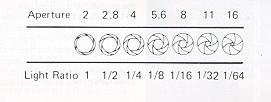
Viewing and focusing
First make sure your lens is securely attached to the camera by turning it
clockwise until no further movement is possible.
| Look through the viewfinder eyepiece (32) and you can feel safe in the knowledge that there'll be no parallax problems (no more cut-off heads in close-up portraits and the like) as you are viewing and focusing, by means of a ground-glass screen, through the actual lens that takes the finished picture. There is a built-in safety margin of course, in common with many other modern single lens reflex cameras, the viewfinder showing an overall area somewhat smaller than the total film area. This ensures that everything you see in the viewfinder appears in the finished picture despite the fact that slide mounts and masks in printing equipment actually cover part of the films image. |
|
Focusing should always be carried out with the
aperture wide open, unless of course you want to preview 'depth-of-field, so
follow the previous instructions concerning aperture operation. With the
camera held to your eye turn the Focusing Ring (11) towards
the right for close distances or towards the left for far distances, until the
subject is sharp and clear on the large ground-glass screen. The Zenith TTL
camera has in addition in the center of its screen, two aids for speedier
critical focusing, a microprism spot which is composed of literally hundreds
of tiny prisms that distort and accentuate an out-of-focus image. Simply focus
the lens until you obtain a single undistorted image at the center and you are
at the point of sharpest focus. This microprism works well for the majority of
subjects and conditions but for subjects lacking in contrast or color the fine
ground-glass collar around the central spot is probably more helpful -- its
quite handy when using long telephoto and wide angle lenses too. (Aim your
camera at this instruction book from about 2 feet away and you'll see how
these focusing aids work). You can of course also use the Distance Scale
(12) of your lens, which is calibrated in meters, to set the focus.
Generally there's no need to check distance, its almost always easier to use
the viewfinder the only time it becomes necessary is when taking flash
pictures (see p.24) or when 'depth-of-field' is important.
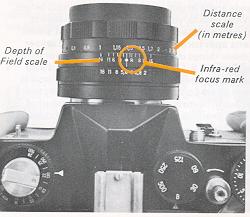
Depth-of-field
All photographic lenses, when focused on a given subject, will show some
objects in front of and behind that subject more or less sharply. This 'range
of extra sharpness is called "depth-of-field" and varies with different
lenses; its greatest with wide angle lenses, and least with telephoto lenses.
With any lens, you'll find your depth-of-field is always greater (more things
in focus) at small lens apertures such as f/11 or f/16 and lesser (fewer
things in focus) at larger lens apertures such as f/3.5, f/2.8 or f/2.
Depth-of-field is also greater in cases of more distant subjects than it is
with close-up subjects and increases nearly twice as much beyond the subject,
your main point of focus, than it does in front of the subject (towards the
camera).
If your picture is such that you want both nearby and distant objects to be in sharp focus then generally the smallest possible aperture should be used. However, the aesthetic quality of a picture can often be improved by having the principal subject in sharp focus while other objects in the scene are soft and out-of-focus. Here a larger aperture is necessary to produce the "differential focus" that de-emphasizes distracting background and/or foreground detail and thus isolates, and concentrates your viewers attention on, the principal subject.
You may want to preview depth-of-field prior to exposure. This can be done in two ways, first by pressing the Shutter Release Button (3) smoothly until it reaches the definite stopping point, just before firing the shutter. This closes the aperture down to its pre-set value and enables you to get an idea (despite the dimness) of what will or will not be sharp -- the final photograph will be at least as sharp if not sharper than the viewfinder image. The second method is to turn the Auto/Manual Switch (23) to the "M" position which has the effect of manually closing the aperture down to the selected lens opening --this is probably easier to master than the first method but you must remember to return the Switch after use to the "A" position ready for normal operation.
Using the depth-of-field scale (13)
The scale consists of the aperture numbers repeated each side of the Distance
Index (10) and shows, at any given focus distance, the nearest limits and
furthest limits of acceptable sharpness. Taking the Helios 44M lens as an
example, if this is focused at 4 meters, the depth-of-field stretches from 3
meters to 6 meters at an aperture of f/5.6 while at an aperture of f/16
objects from 2 meters to infinity (oo) will be acceptably sharp in the final
picture. Note: For the sake of reading clarity some figures are omitted from
the scale; however, its a simple matter to 'fill in those missing if you
remember they follow the aperture sequence exactly, with those proceeding left
from the index (10) showing the near limits of sharpness, and
those proceeding right showing the far limits.
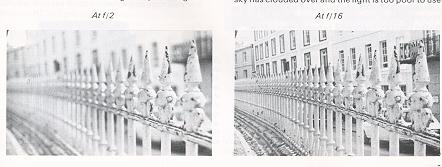
Now for some practical examples
(a) You're taking a landscape view where you want
everything needle-sharp from the foreground all the way to the background.
Easy you say, close the aperture right down to f/1 6-- the snag is that the
sky has clouded over and the light is too poor to use this aperture at a
reasonable shutter speed. The remedy -- obtain the maximum depth-of-field
required with the minimum of 'stopping-down (decreasing aperture size). Focus
through the viewfinder on the closest object and note the distance (say 3m)
registered against the Index (10), then focus on the most
distant part of your subject and note this distance (say 10m) also.
Now look at your lens and move the Focusing Ring (11) until
both distances appear just between an identical pair of aperture numbers (f/8,
in above example), on the Depth-of-Field scale (13). Set the
lens to the aperture thus found, use your exposure meter to determine the
correct shutter speed for an exposure at this aperture, then set this speed on
the Shutter Speed Dial (1). Everything between the two distances (3 to 10
meters) shown by the matching aperture numbers (f/8) on the Depth-of- Field
scale (13) will appear sharp in the final photograph. (b) If
you need absolute maximum depth-of-field at any given aperture focus on the
'hyper focal distance. This is found by aligning the infinity mark (00)
against the Distance Index (10). The distance then found to
be aligning with the near limit of depth-of-field for the aperture required
will be the 'hyper focal distance. If the lens is now refocused so that this
distance aligns with the Index (10) everything will be sharp
from half the distance to infinity.
(c) To obtain a "differential focus" effect, determine the closest and most
distant parts of your subject as described in example (a) above, then refocus
the lens so that the distance of the important part of your subject aligns
with, or is near to, either the near or far limits (according to whether you
want foreground or background out-of-focus) on the Depth-of-field scale
(13) when using a largish aperture, say f/4. Set lens and camera
controls as necessary and you'll be assured of obtaining a picture of high
subject impact.
| Here we can see that the 10 meter focus setting is in fact the hyper focal distance for an aperture of f/8 which gives us the maximum depth- of-field possible from that lens, extending from half that distance (5 meters) to infinity. |
|
Taking the
picture
Poor first-time results are largely attributable to camera shake, so its very
important to hold the camera steady using both hands. You will probably find
it most convenient to grip the camera firmly with your right hand and fire the
Shutter Release Button with your right fore-finger. This way your left hand
can easily turn the Focusing Ring and give extra support at the same time.
Always press the Shutter Release Button downwards smoothly and firmly-- NEVER
jab at it.
|
|
|
|
Note the extra support the left hand gives and the "correct" finger position for smooth release of shutter. |
|
For each Successive Exposure. . . just move the Transport Lever until fully wound and you're ready for your next shot. If lighting conditions have not changed it is only necessary to frame the subject, focus and fire the shutter. If taking a photograph in a slightly different direction or if the sun clouds over, take a further meter reading and make any adjustments to camera and lens controls that might become necessary before firing the shutter.
Note: Keep an eye on the Frame Counter (5). When this registers a figure indicating that the entire length of film has been exposed, or if the Film Transport Lever cannot be turned, it is time to rewind the film into its cassette ready for processing. DO NOT try to get an extra exposure -- if the Transport Lever is wound forcibly the film may be damaged and disengage from the cassette making it impossible to rewind.
Removing exposed film
(1) Before attempting to rewind a film put the cap, supplied with
your camera, back on the lens. This is simply a precautionary measure to
prevent any portion of the last frame being exposed to light, since the Rewind
Release has the effect of firing the shutter even if, as sometimes happens,
the Transport Lever is only partly wound when the end of the film has been
reached.
(2) Releasing the film for rewinding. The Zenith TTL has a
locking device which permits rewinding without constant application of
pressure.
To engage it first press the Shutter Release Button (3) then
turn the Rewind Release Ring (4) fully anti-clockwise. Make
sure the Ring is turned until no further movement is possible and you'll then
be able to rewind the whole film quite freely.
(3) Rewinding. To rewind the film it is necessary to lift the
crank handle out of its recess and into the position as indicated below. The
Rewind Knob (18) should be gripped firmly by the crank and
rotated in a clockwise direction (as indicated by the engraved arrow). While
resistance is felt you are rewinding the film back into the cassette (the knob
will turn freely without resistance when the film has been fully rewound).
(4) Having rewound the film, remove the camera from its case, raise
the Back Catch (16) and swing the Camera Back (27)
open. Pull the Rewind Knob (18) upwards fully and take the
cassette of exposed film out of its Chamber (22). Your film
is now ready for processing.
(5) The camera can now be reloaded (after observing
precautions on p.3). If you don't want to reload till a later date return the
Rewind Knob to its 'closed position.

|
1. The Shutter Speed Dial (1) must be set at 1/30th second when using electronic flash.
2. Small light weight flash guns may be safely clipped into the Accessory Shoe (19) on top of the camera. Some electronic guns being heavier may need a separate mounting bracket or 'flash bar which screws into the Tripod Bush (25) at the bottom of the camera. |
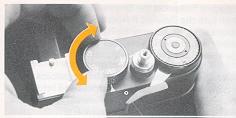 |
3. Plug your flash gun lead into the Flash Synchronization Socket (7) making sure its tip is pushed in firmly.
Obviously the type of calculator dial or scale will vary with each make of gun, so consult the instruction book supplied with your unit, or your dealer for exact information -- the general operating rule however is.,.
4. Look through the viewfinder and focus on your subject. You can then find from the calculator dial! scale the correct lens opening for the actual camera-to-subject distance that is shown by your lens' Distance Scale (12).The Aperture Ring (14) must then be set accordingly.
Do not press down on Shutter Release Button (3) unless actually taking a flash picture since this will fire the flash even if the Transport Lever (2) has not been wound. However, there will be no loss of film should this happen.
If the flash unit does not fire when you press the Shutter Release Button
(3) make sure that the lead is securely plugged into the Flash
Synchronization Socket (7) and check that unit is
switched on.
|
|
|
| 3. Turn the Self-Timer Lever (9) downwards in an anticlockwise motion until no further movement is possible. (As you move this Lever on the camera you'll see an "M" sticker beneath it which is there simply to remind you to set the lens to the Manual position as previously mentioned.) | 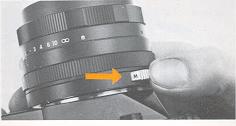 |
4. Now press the Self-Timer Release Button (8) and move
into the picture area as quickly as possible. The Lever (9)
will slowly return to its normal position releasing the shutter
automatically during its travel.
|
|
|
| To remove the lens just grip the whole barrel firmly and give it about three turns to the left (anti-clockwise). To attach a lens simply screw it firmly into the cameras mount in a clockwise direction; when it stops, give it a slight extra twist to ensure that it is securely attached. Note -- when refitting lenses with an auto-manual control, such as the standards lens fitted on the Zenith TTL, make certain that the lens is set to the 'A position before taking further photographs. This ensures that you will be able to frame and focus easily. | 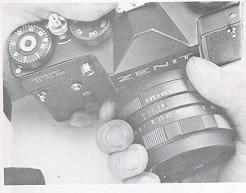 |
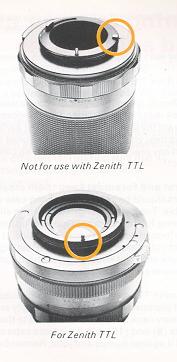 |
|
Caring for your camera and accessories
Your Zenith is a ruggedly-built camera designed to provide many years of
dependable performance. If you want the longest service and best
performance, always treat your camera and accessories as you would any
precision instrument -- with care and respect!
The Zenith TTL camera can be carried outside its case if preferred (your dealer can supply an accessory neck strap which attaches to the body eyelets (6) and (15), but if it is; take extra care to guard it against bumps and jolts. Remember too that on the beach, sand and sea-spray somehow seem to get everywhere; even a closed carrying case needs extra protection.
The lens in particular, which can be quite easily scratched, should be protected at all times an Ultra-Violet filter is very good here since it needs no exposure correction and can therefore be kept on the lens almost permanently as protection against dust and the weather.
NEVER touch the lens or mirror surfaces with the hands. Fingerprints diminish optical efficiency and due to natural skin acidity may in time damage the delicate optical coating of the lens and surface silvering of the mirror--silvering of the mirror-only an air blower (bulb type or similar) should be used for removal of dust. Any stubborn traces of dirt or condensation left on the lens after this can be removed by lightly wiping over the surface with a clean soft piece of lint-free fabric or cotton (or a pad of surgical cotton-wool on the end of a matchstick) that has been dampened with absolute alcohol, ether or other spirit mixture; any smears can be removed with a dry soft cloth. NO ATTEMPT should be made to clean the mirror or viewing screen by wet means - air cleaning only is allowed and this is usually best left to a specialist.
Trouble shooting
Your Zenith camera is designed to give you thousands of pleasurable
photographs. Like any precision instrument, your cameras controls must be
operated correctly for best results. Should you
| If this happens..... | Here is why.... | And how to correct it.... |
| Prior to loading Film Sprockets (24) free-wheel and don not turn when Transport lever (2) is turned. | Rewind Release Ring (4) not turned fully to the right (clockwise). | Turn Rewind Release Ring completely to the right until no further movement is possible. |
| After loading Frame Counter (5) skips two or more numbers after being set to '0' position. | Film Transporter Lever (2) not fully wound before counter is set to '0' position. | Advance Transport Lever fully before setting counter to '0' |
| Frame Counter (5) 'skips" counting incorrectly | See-above-or Counter set before Transport Lever was wound | See above-always wind Transport Lever before setting counter. |
| Shutter Release Button (3) does not trip shutter. | Film Transport Lever (2) not fully wound. | Always operate Transport Lever in two strokes. It will stop mid-way during the second stroke assuring you that shutter is completely wound. |
| Film Transport Lever (2) does not stop after two or more strokes. | Rewind Release (4) not turned fully clockwise so that three dots are lined up. Shutter Release Button (3) not turned fully clockwise (to the right). | Turn Rewind Release Ring and Shutter Release Button completely to the right, until no further movement is possible. |
| Self -Timer does not trip shutter. | Self-Timer Lever (9) not fully wound. Transport Lever (2) not wound. | Wind Self-Timer fully until lever points downwards with no further movement possible Always ensure Transport Lever is fully wound before setting Self-Timer Lever. |
| Lens does not close down to indicated aperture when Self-Timer is used. | Auto/Manual Switch (23) on lens not set on 'M' | Move Auto/Manual Switch to 'M' whenever Self-Timer is used. |
If anything should go wrong with your Zenith and the preceding chart has not
got you out of trouble, NEVER attempt to mend it yourself--you could turn a
minor adjust men into an expensive repair.
Remember that your Zenith and its accessories are backed up by top-class
service facilities where factory-trained specialists are available to put
things right, quickly and inexpensively.
Composition or...Taking better pictures
Composition is concerned with what you put into your picture and where; its final control lies in your hands. A slight amount of extra thought and/or effort on your part can often turn what would have been an otherwise ordinary-looking photograph into one which is stunningly attractive. There are so many factors involved that probably thousands of books have been written on this aspect alone however here are some basic picture-taking tips that will help you take better pictures starting right from your very first roll of film .
- Isolate your subject - Concentrate your viewer's attention on the subject of your photograph, move in as close as possible, filling the viewfinder frame and eliminating all extraneous foreground and background detail. Remember that you can safely compose direct in the viewfinder, you see what the lens sees (in fact there'll be a little more actual film image as previously mentioned due to the viewfinder's built-in safety margin). Another way to eliminate extraneous detail and gain impact for your subject is to use the 'differential focus' technique described on page 20. With some subjects (e.g. sporting events, wildlife, distant objects of all kinds) you're unable, or it's inconvenient, to get in close - here a telephoto lens scores as it "compresses" space making distant objects appear closer. Taking in less of the field of view it also teaches you to be selective in choice of subject and viewpoint.
- Keep it simple - a few bold masses nicely contrasting with each other are more pleasing to the eye than a confusion of small detail. Aim to achieve balance more than symmetry. Have objects of uneven size balancing each other rather than a geometric arrangement of equal sized objects. Choose surroundings and backgrounds carefully those that complement your subject rather than take interest away from it. A person standing in front of a fussy background such as a building (unless it is 'thrown out of focus') is seldom as attractive as a close-up of the same person against a background of trees or clear sky.
- With color - Complementary colors suggest harmony - clashing colors suggest conflict. Pastel shades with a tiny, brightly-colored accent can be more effective than masses of strong color. The camera is not as selective as the eye, which is why a bed of mixed flowers is rarely a good subject or color film.
|
|
|
|
|
Choosing and using accessories
|
Illustrated here is the range of Helios quality lenses and optical
accessories (for technical specifications see page 40 ). Such a vast
assortment of ancillary equipment is available for your Zenith TTL
(both from the USSR and a multitude of other sources) that we can only
give very brief details hereof the when, why and how of choice and
use.
|
Wide-Angle Lenses -- are available in focal lengths from 1 6mm to about 35mm, the shorter the focal length the wider the area covered. They are situations they allow you to retain sufficient of more used in any Situation that requires greater-than- normal area coverage, e.g. landscapes, interiors, distant surroundings or background to show relationship to an important close-up subject. Generally a 28mm or 35mm type is found most useful since they're relatively inexpensive, usually have wider maximum apertures, and are less prone to distortion than the shorter focal lengths. |
|
|
|
Telephoto Lenses are available in focal lengths from 85mm (1 .5 x magnification compared to standard lens) to about 1000mm. A 1 35mm lens is generally found to be most useful, certainly for candid photography (children at play, people strolling, street buskers etc), as in most cases you'll find you get a large enough image on the film, and, because you're further away than normal, more pleasing perspective and some beautifully relaxed and natural expressions. For longer range work (e.g. stadium sports, animals) a 200mm or even a 300mm lens could be a useful addition.

Teleconverters will give you a telephoto effect from any lens fitted to your
camera at far less expense than a specialist lens and often with much less
total weight (a great boon on a photo-safari). Two Helios Automatic models
(detailed on p. 40) are available, which, when fitted between camera body
and lens, either double or treble the focal length of that lens. Say for
example you have your standard lens plus a 1 35mm lens -- with the 2x
converter you would convert these to lenses of 11 6mm and 270mm focal length
respectively; with the 3x converter they would become 1 74mm and 405mm.
Teleconverters give you almost unlimited scope -- and you gain in focusing
range, since the minimum focusing distance of your prime lens is not
affected by the converter. For example, the Helios Auto 1 35 has a focusing
range of 1 .5m to infinity; whether the 2x or 3x converter is used, the
resultant combination still focuses from 1 .5m to infinity, giving you a
telephoto lens that allows you to get in really close.

Chart on Helios lenses
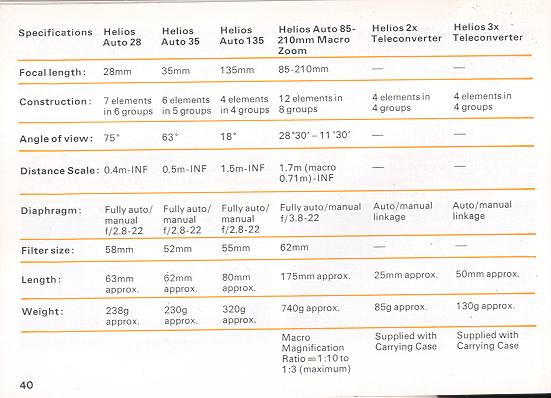
Close Up Photography comes easy with your Zenith. Many pictures (say of two or three flowers, book or magazine illustrations) can be taken without any accessory at all --just turn the Focusing Ring (11) of your standard lens to its minimum distance and move your camera towards the subject until the viewfinder image is at its sharpest. . . you'll find you can fill the frame with an object around 6 1/2 x 1 0 in in area. For smaller subjects you need to get closer by using a supplementary close-up lens screwed into the filter mount of your standard lens or extension tubes or bellows unit inserted between camera and lens.
Supplementary lenses, are easiest to use since they do not require any exposure increase -- not that this is a problem with the Zenith TTL, thanks to automatic meter compensation. A slight disadvantage is that because they add another glass-to-air surface they do impair the fine resolving power of the camera lens at the edge of the field unless the aperture is stopped well down. Helios Close-up Supplementaries, being fully-coated optics, reduce this quality loss to the minimum. They are available in the most popular powers of +1, +2 and +3 dioptres (the higher the number. the closer you can approach your subject). Consult your dealer for the best type to suit your needs.
|
Helios Supplementary Lenses Approximate Focusing Distances (cm) |
|||
| Camera Lens |
set at |
||
| Lens Type | 1m | 2m | 00 |
| +1 dioptre | 50 | 67 | 100 |
| +2 dioptre | 33.5 | 40 | 50 |
| +3 dioptre | 25 | 28.5 | 33 |
|
|
|
Extension Tubes allow photography at even closer range than supplementary lenses. Normally sold in sets of 3 varying lengths, they can be used singly or in any combination to provide a number of fairly definite magnification steps, allowing you to fill the frame with subject sizes from about 2.7in x 4in to as small as 1 din x 1 in (life size). A bellows unit offers even further advantages since magnification is considerably greater and also continuously variable over a wide range (ideal for really small and even live subjects like insects). Subjects ranging from 0.8in x 1 .2in to 0.4in x 0.6in (2.5 times life size - or even greater depending on lens in use) will fill the viewfinder frame. * Both extension tubes and bellows units, because they make the light rays travel a Greater distance as the lens is moved further from the film, require an increase in exposure over that indicated by a meter reading. This increase varies i n proportion to the amount of extension and the focal length of the lens, and is normally computed from data tables supplied with tubes and bellows. Since the exposure meter in your Zenith TTL automatically compensates for any exposure increase required, this disadvantage is reduced to nil, leaving these plus factors: (a) optical performance is not impaired in any way and (b) a greater and more varied magnification range is obtainable. |
|
|
Photomicrography - yes, you can even take pictures through a microscope with your Zenith! At moderate magnifications no accessory is needed other than a rigid tripod or copy-stand to hold your camera, complete with lens, over the eyepiece of the microscope. For more professional results and and at higher magnifications the camera body should be attached direct to the microscope by means of a 42mm thread mount GA-3 Microscope Adaptor (obtainable through your dealer or direct from Zenith House). |
| (NEVER use a hood intended for long focus lens with a shorter focus lens.) Filters, usually made of colored glass or gelatins, are used to create special effects or improve rendering or contrast with color or black and white films. The present Hellos Filter range, as you will see from the details below, gives very good general-purpose coverage. All are fully-coated and come in individual twist-lock cases. Since a filter absorbs extra light, compensation is normally made by increasing the aperture (f/stop) by the factor engraved on the filter mount. With the Zenith TTL, the CdS meter once again provides automatic compensation. | 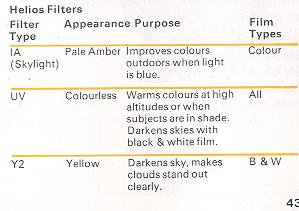 |
|
SPECIFICATION
GN 32: ASA25/ft GN 63: ASA 1 00/ft GN 18: ASA1 00/meter Flash duration: 1/2000th sec
|
|
|
SPECIFICATION Magnification: 2.5 x up to 8 x, automatic or manual. Larger than baseboard size, manual only. Supplied complete with lens and 75W lamp. |
|
We are sure you'll find the preceding few brief pointers helpful in improving technique with your Zenith. Remember every time you raise your camera to your eye you have the potential of creating a genuinely great photograph. Subjects? -- the world is full of them --the rest is up to you...